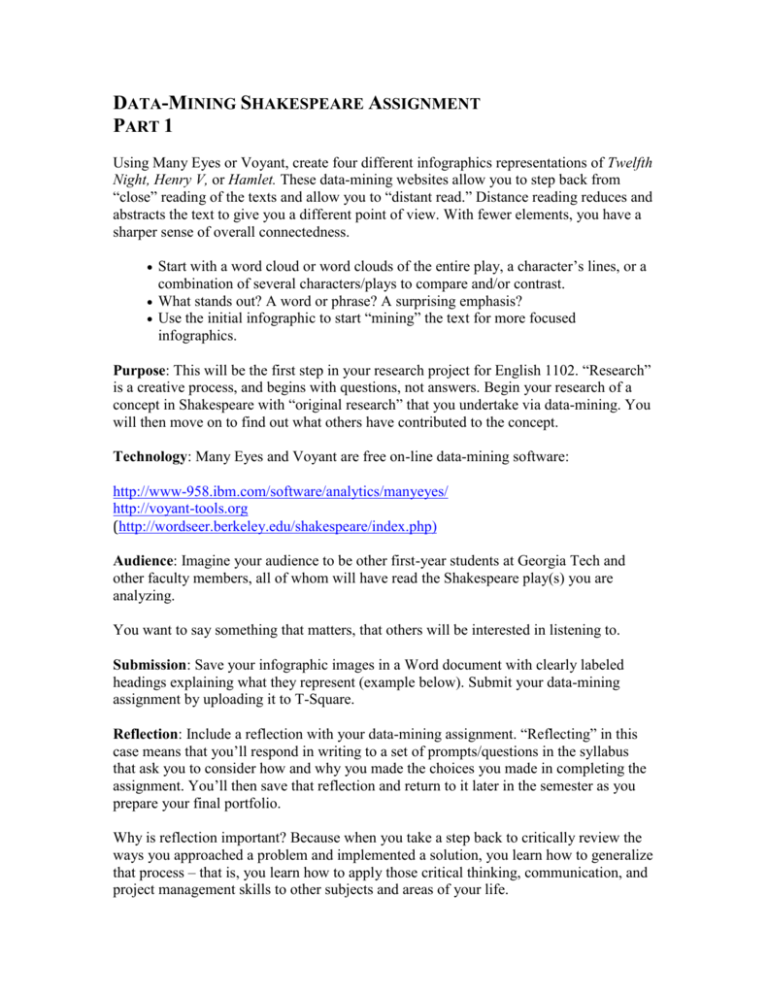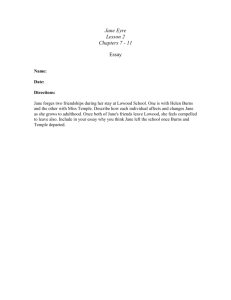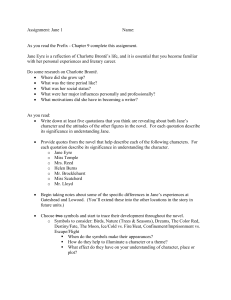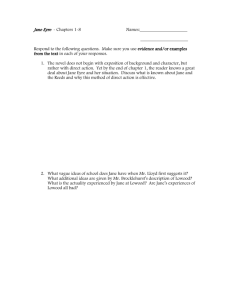DATA-MINING SHAKESPEARE ASSIGNMENT PART 1
advertisement

DATA-MINING SHAKESPEARE ASSIGNMENT PART 1 Using Many Eyes or Voyant, create four different infographics representations of Twelfth Night, Henry V, or Hamlet. These data-mining websites allow you to step back from “close” reading of the texts and allow you to “distant read.” Distance reading reduces and abstracts the text to give you a different point of view. With fewer elements, you have a sharper sense of overall connectedness. Start with a word cloud or word clouds of the entire play, a character’s lines, or a combination of several characters/plays to compare and/or contrast. What stands out? A word or phrase? A surprising emphasis? Use the initial infographic to start “mining” the text for more focused infographics. Purpose: This will be the first step in your research project for English 1102. “Research” is a creative process, and begins with questions, not answers. Begin your research of a concept in Shakespeare with “original research” that you undertake via data-mining. You will then move on to find out what others have contributed to the concept. Technology: Many Eyes and Voyant are free on-line data-mining software: http://www-958.ibm.com/software/analytics/manyeyes/ http://voyant-tools.org (http://wordseer.berkeley.edu/shakespeare/index.php) Audience: Imagine your audience to be other first-year students at Georgia Tech and other faculty members, all of whom will have read the Shakespeare play(s) you are analyzing. You want to say something that matters, that others will be interested in listening to. Submission: Save your infographic images in a Word document with clearly labeled headings explaining what they represent (example below). Submit your data-mining assignment by uploading it to T-Square. Reflection: Include a reflection with your data-mining assignment. “Reflecting” in this case means that you’ll respond in writing to a set of prompts/questions in the syllabus that ask you to consider how and why you made the choices you made in completing the assignment. You’ll then save that reflection and return to it later in the semester as you prepare your final portfolio. Why is reflection important? Because when you take a step back to critically review the ways you approached a problem and implemented a solution, you learn how to generalize that process – that is, you learn how to apply those critical thinking, communication, and project management skills to other subjects and areas of your life. Grading: This assignment is worth 5% of your overall grade and will help you formulate and defend your researched essay’s central claim. Sample: In 2011, Cary Fukunaga adapted Charlotte Bronte’s 1847 novel, Jane Eyre. Bronte wrote the novel in the first person, with Jane, the title character, narrating the story. The reader sees Jane’s world through her eyes. Fukunaga focus the camera not behind Jane’s eyes, but on Jane herself: Jane asleep in Rochester’s bedroom, Jane running across the moor, Jane standing on the chair at school. Fukunaga’s focal point on the body of Jane (Actress Mia Wasikowska) represents a considerable shift from Jane’s own dynamic perspective in the novel, where we see things through her, framed in her keen language. In Bronte’s Jane Eyre, Jane narrates a gaze on herself 31 times: Contrasting with more than three times that many instances of what Jane sees:






